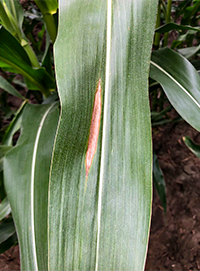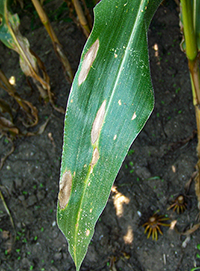Northern corn leaf blight is an annual threat in cornfields from the Midwest to the Atlantic Coast, wherever environmental conditions are met. It spreads quickly from south to north, riding hurricane winds to infect new areas.
Many factors contribute to the risk of northern corn leaf blight damage. Climate, moisture, cropping system, timing, tillage practices and soil content should be taken into account when assessing fields for disease risk.
Timing
 Late-planted corn is exposed to disease at vulnerable early growth stages and can suffer higher levels of infection. Significant yield loss can occur if leaf area is destroyed before grain fill is complete. Early infection allows secondary outbreaks, disease spread and leaf damage to create even greater yield losses.
Late-planted corn is exposed to disease at vulnerable early growth stages and can suffer higher levels of infection. Significant yield loss can occur if leaf area is destroyed before grain fill is complete. Early infection allows secondary outbreaks, disease spread and leaf damage to create even greater yield losses.
Management tips
Hybrids with partial resistance to northern corn leaf blight typically produce fewer, smaller lesions and fewer fungal spores. Hybrids with race-specific resistance display small yellow lesions and produce no spores. Lesions may appear on leaf sheaths and husks of susceptible hybrids.
Choose resistant corn varieties with your retailer, rotate crops, till fields to encourage decomposition of infected residue, and apply a fungicide preventively or, if necessary, curatively.
Recording scouting notes and field observations in tools like Granular Insights are helpful for planning in-season rescue applications and serve as a historical record of location, severity and time of outbreaks for next year's planning.
Impact on yield
Early season infection can have a serious impact on yield, with losses up to 30%.
Symptoms
 Elliptical, gray to tan lesions on leaves. Lesions can be anywhere from 1 to 6 inches long. Symptoms tend to start on lower leaves.
Elliptical, gray to tan lesions on leaves. Lesions can be anywhere from 1 to 6 inches long. Symptoms tend to start on lower leaves.
Under high humidity, spores coating the lesions turn olive-green or black, giving leaves a dark or dirty appearance.
Conditions for development
- Moderate temperatures (65 F to 80 F), precipitation and high humidity create the optimal environment for northern corn leaf blight. Long periods of dew and overcast days can trap moisture in the crop canopy, encouraging infection. Strong winds and rain spread disease from soil to and among developing plants.
- Infection requires leaf surfaces to be wet for 6 to 18 hours.
- According to the University of Illinois, high nitrogen levels in the soil increase the risk of northern corn leaf blight.
Get Your Disease ID Guide
Learn the timing, signs and treatment for common crop diseases with the Corn & Soybean Disease ID Guide.
Aproach® and Aproach® Prima are not registered for sale or use in all states. Contact your state pesticide regulatory agency to determine if a product is registered for sale or use in your state. Always read and follow label directions.